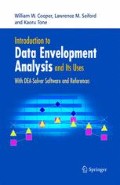Access this chapter
Tax calculation will be finalised at checkout
Purchases are for personal use only
Preview
Unable to display preview. Download preview PDF.
Notes
M.J. Farrell (1957), “The Measurement of Productive Efficiency,” Journal of the Royal Statistical Society Series A, 120,III, pp.253–281. G. Debreu (1951), “The Coefficient of Resource Utilization,” Econometrica 19, pp.273–292.
R. Färe, S. Grosskopf and C.A.K. Lovell, Measurement of Efficiency of Production (Boston: Kluwer-Nijhoff Publishing Co., Inc., 1985).
K. Tone (2002), “A Strange Case of the Cost and Allocative Efficiencies in DEA,” Journal of the Operational Research Society 53, pp.1225–1231.
This ratio model was introduced in K. Tone (1993), Data Envelopment Analysis (in Japanese) (Tokyo: JUSE Press, Ltd.).
W.W. Cooper, Z. Huang, S. Li and J.T. Pastor (2005) “Aggregation with Enhanced Russell Measure in DEA,” European Journal of Operational Research (forthcoming).
K. Tone and M. Tsutsui (2004), “Decomposition of Cost Efficiency and its Application to Japan-US Electric Utility Comparisons,” Research Report Series I-2004-0004, GRIPS (National Graduate Institute for Policy Studies), also forthcoming in Socio-Economic Planning Sciences.
W.W. Cooper, K.S. Park and J.T. Pastor (1999), “RAM: A Range Adjusted Measure of Inefficiency for Use with Additive Models and Relations to Other Models and Measures in DEA,” Journal of Productivity Analysis 11, pp.5–42.
K. Tone and B.K. Sahoo (2005), “Evaluating Cost Efficiency and Returns to Scale in the Life Insurance Corporation of India Using Data Envelopment Analysis,” Socio-Economic Planning Sciences 39, pp.261–285.
K. Tone and B.K. Sahoo (2005), “Cost-Elasticity: A Re-Examination in DEA,” Annals of Operations Research (forthcoming).
H. Fukuyama and W.L. Weber (2004), “Economic Inefficiency Measurement of Input Spending When Decision-making Units Face Different Input Prices,” Journal of the Operational Research Society 55, pp.1102–1110.
R.G. Chambers, Y. Chung and R. Färe (1996) “Benefit and Distance Functions,” Journal of Economic Theory 70, pp.407–418.
R. Färe, S. Grosskopf and G. Whittaker (2004) “Distance Functions,” Chapter 5 in W.W. Cooper, L.M. Seiford and J. Zhu, eds., Handbook on Data Envelopment Analysis (Norwell Mass., Kluwer Academic Publishers).
S. Ray (2004) Data Envelopment Analysis: Theory and Techniques for Economics and Operations Research (Cambridge University Press).
See Note 1. See also M.J. Farrell and M. Fieldhouse (1962), “Estimating Efficient Production Functions Under Increasing Returns to Scale,” Journal of the Royal Statistical Society Series A, 125, Part 2, pp.252–267.
See the Note 1 reference.
17. See the Note 2 above. See also R. Färe, S. Grosskopf and C.A.K. Lovell (1994), Production Frontiers (Cambridge: Cambridge University Press).
Rights and permissions
Copyright information
© 2006 Springer Science+Business Media, Inc.
About this chapter
Cite this chapter
(2006). Allocation Models. In: Introduction to Data Envelopment Analysis and Its Uses. Springer, Boston, MA. https://doi.org/10.1007/0-387-29122-9_8
Download citation
DOI: https://doi.org/10.1007/0-387-29122-9_8
Publisher Name: Springer, Boston, MA
Print ISBN: 978-0-387-28580-1
Online ISBN: 978-0-387-29122-2
eBook Packages: Business and EconomicsBusiness and Management (R0)

